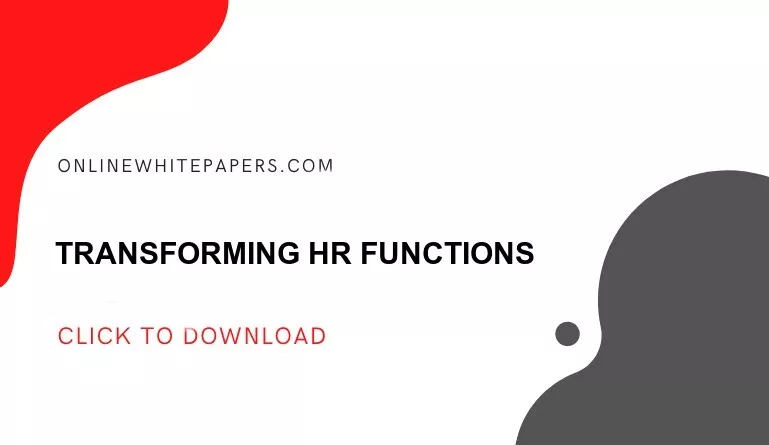The days of HR functional areas being limited to simply employing candidates and maintaining paper records are long gone. HR responsibilities have grown in importance to an array of stakeholders, constituting both employees and clients due to the unprecedented challenges. It has emerged within and beyond the workplace, in a fast-changing and fast-paced global workplace were sustaining a competitive advantage is critical to success.
Today, HR functions form an indispensable component at the workplace, not just for individual employees in terms of maintaining them but also for interdependent associates. Reports suggest that poor HR practices can have negative consequences on the performance and overall productivity of the organization.
Innovative HR and procedures play a critical role in developing an indigenous U-P-S(Uninterrupted -Manpower -Supply) in alliance and compliance with the external environment that affects the entire organization and its productivity.
Human Resource Management (HRM) Decoded
HRM is a strategic procedure to organize people in a company or organization to assist the company in acquiring an edge over its competitors. It is a consolidation of distinguished functions, features, and influencers, both tangible and intangible, assimilated together to enable employers to achieve their strategic goals by maximizing employee performance.
In this post, we will discuss 15 critical functions of human resource management.
-
Planning for Human Resources
HR anticipates market drifts and devises a plan to recruit and engage people whose interests are aligned with the company’s objectives.
Human resource planning guarantees that employees and jobs are a good match while preventing labor shortages or surpluses. The HR planning procedure is divided into four phases. They include analyzing current labor supply, projecting labor demand, balancing predicted labor demand with reserve, and assisting in achieving organizational objectives.
-
Recruitment of the Best Fit for the Job
Recruitment is a hiring process in which the company’s staffing and organizational needs are first identified. Recruitment is critical since it serves as a prerequisite for selection. Recruitment is a deciding factor in onboarding the best applicants in the selection process, which should be the best-fit candidate.
It’s a continuous process with many variables that an HR engrosses in the system to ensure a smooth workflow and high production. A strong pool of applicants, precise qualification screens, proactive strategic alignment with corporate goals, lower attrition, and high morale are all primary benefits of effective recruiting and selection processes.
-
Performance Management Process
Planning, coaching, reviewing, and rewarding are the four essential elements that form the performance management process. Each phase is critical, and they all work together to build the foundation of a company’s performance management process.
Performance management is the set of activities and processes that focus on skills, resources, and support to maintain and improve employee performance aligned with an organization’s objectives. It includes KPIs, which is a quantitative assessment of performance over time for a specific goal. It also has objectives, performance reviews, feedback, learning, and development as a performance indicator.
According to research, employees who receive regular feedback on their abilities are on average 8.9% more lucrative (Gallup, 2016).
-
Development and Learning Program
HR creates and incorporates a learning and development program, a systematic plan to improve an employee’s skills, knowledge, and competency to perform better at work. Learning, training, and development are all terms that are frequently interchanged.
Training and development benefit businesses in attracting and retaining top employees, improving employee satisfaction and morale, increasing productivity and increasing profits. Additionally, companies with actively engaged and dedicated staff have a 41% lower absence rate and a 17% better productivity rate.
-
Career Path defining
A career is described as “a series of jobs that make up what a person earns a living.” According to Schermerhorn, Hunt, and Osborn, career planning is a process of carefully connecting career goals and individual talents with chances for their fulfillment. The process of increasing an employee’s future value is known as career planning.
A career plan is a person’s decision about the occupation, organization, and career route to pursue. HR encourages potential employees to investigate and gather information as part of their career planning, which allows them to synthesize, gain competencies, make decisions, and create goals.
-
Information Sharing
In the business world, poor communication may be highly costly. It could lead to decisions based on erroneous assumptions and untrustworthy facts. HR enables transparency and increased data or information exchange across the organization. This can be accomplished through cloud-based systems that encourage openness and collaboration.
HR’s instill systems that accomplish information sharing tasks by sending a newsletter to keep everyone informed about the newest developments. It includes safety measures, layoff announcements, mergers and acquisitions, and any other significant event affecting employees. To establish and maintain help and successful organizational change, it is vital to share knowledge clearly and in an optimal manner.
-
Rewards and Recognition for Performers
Employees that are satisfied, loyal, and eager to advance up the ladder are more likely to stay with the company if they have a decent reward system. Employees are motivated to work harder by rewards such as public praise and increased compensation. Rewards and recognitions attract fresh employees to the company. It saves money by not having to hire and train new personnel.
Peer pressure, termination, and other high-stress behaviors aren’t necessary to encourage individuals in highly productive workplaces. Instead, these businesses use techniques like employee recognition, one-on-one meetings, and 360-degree feedback to boost productivity.
HR understands that monetary rewards are simply a tiny portion of the overall reward system. New-gen employees regard public appreciations, appraisals, and acknowledgments as more encouraging reward systems over financial rewards. Hence the HR now creates a reward and recognition system that cohorts the company culture and employee expectations.
-
Benefits and Compensation Advantages to Induce Motivation
Compensation and benefits are an undeniable part of HRM since they keep employees motivated. It assists in providing advantages to employees depending on their performance and activities and bringing out the best in individuals at work.
Salary, long-term incentive plans (LTIPs), short-term incentives (STIs or bonuses), paid costs, and insurance is the few fundamental types of compensation that drive the employees to achieve and sometimes overachieve.
The benefits package includes insurance, medical, vacation, leaves, retirement, taxes, travel allowance, meals, and lodging. These benefits induce a sense of loyalty in the employees. They feel assured and perform stupendously well to earn more benefits such as commissions, bonuses, profit sharing, merit pay, and stock options.
-
Industrial Relations creates a bond between Employee and Employer
The term “industrial relations” refers to the interactions between employees and their bosses in the workplace. From this perspective, industrial relations encompass all facets of the employment relationship, including human resource management, employee relations, and union-management (or labor) relations.
The most crucial advantage of industrial relations is that it assures production continuity. The resources are used to their most significant potential, resulting in the highest possible output. There offer a constant stream of revenue for everyone.
A healthy industrial relation helps transform the employee into a brand ambassador who represents and sometimes advocates his company in the open market.
-
Policy Development
Policies are the set of regulations that are implemented to ensure the smooth functioning of the organization negating discrepancies.
The creation of HR policies is influenced by the day-to-day issues that arise in an organization and how they are resolved. The primary goal of developing HR policies is to assist top executives in making decisions in specific situations.
The company’s image should be reflected in policies and procedures. Human resource policy must be well-defined and make the HR policies as user-friendly as possible.
-
Health and Safety Policy
Before the covid pandemic, no one must have realized the importance of health and safety as much as it is significant and relevant now.
Therefore, HR must adopt health and safety precautions to protect the emotional and physical well-being of employees and non-employees. Employees, customers, and visitors on the company facilities should be covered under the Health and Safety at Work Act. Employers should strive to eliminate or considerably reduce workplace accidents by implementing safety measures and first aid training. They must endorse events aimed to spread safety awareness at the workplace and among the workforce.
From the standpoint of employees, it helps to keep them safe and productive at work. This policy also safeguards clients and guests while they are on company property. As a result, health and safety policies are in place to prevent workplace mishaps. It adversely affects the staff’s morale if the employer neglects his duty of care.
-
Personal Well-Being Increase Positivity
Productivity and performance are boosted when employees are happy. Employees that are in good health exhibit healthier behaviors and make better decisions. Therefore, HR strives to create a fair and unbiased work environment where employee morale remains high. When employees’ needs are satisfied on all levels, including physical, emotional, and financial, they feel more capable and respected.
They exhibit improved morale, better cooperation, and strong social networks. A personal well-being initiative increases productivity, reduces absenteeism, higher job satisfaction, and more vital involvement.
According to research, health, work behavior, and the value of employee well-being are all interlinked. Improving the employees’ health and well-being is one approach to get a competitive advantage for the company.
-
Employee Engagement to enhance employee involvement
Employee engagement is the extent to which employees feel a mental and emotional attachment to their workplace. Employees that are engaged are more aware of their surroundings because they are more linked to their workplaces. Employees who do not feel respected challenged or energized at work have low engagement, which implies they are more inclined to seek these qualities elsewhere.
HR must ensure that the employee engagement program is tightly woven with the involvement of employees so that external factors do not affect loyal and talented employees, and they do not fall prey to competitors’ lucrative offers.
-
Compliance with Law
HR specialists are in charge of determining which regulations must be followed. They’re also in the task of conveying those requirements and devising methods for staff to meet them.
Specific federal and state regulations, rules, and standards must be followed and adhered to in every corporate environment. Compliances are what they’re called, and both employers and employees are responsible for following them. The majority of compliance work occurs under the human resources (HR) umbrella within a corporation.
Within any organization, this is a significant and critical role. And it’s one that, if managed incorrectly, may have disastrous consequences for a business and its reputation.
-
HR Administration
HR management is broadly segregated into three major functional areas: administration, change management, and people management. A team of human resources specialists is in charge of delivering successful workforce management and staff development. In contrast, the HR administrator is in charge of coordinating HR tasks and supervising HR administrative staff.
Human resource administration is the management of an organization’s employees’ total employment experience. It involves Recruiting, hiring, and onboarding new employees. This is followed by salaries and benefits definition.
The HR administrator keeps an observation on the maintenance of organizational structures, policies, and job descriptions. Appraisal of performance and assessment also comes under the umbrella of HR administration.
Final Thought
The seamless transition between the HR functional areas would lead to a new horizon of responsibilities. In the case of workforce planning, the future of human resources will entail using data to make strategic decisions.
The HR domain is now expected to experience an expansion that will include HR expects to play the role of championship coaches, leading firms through anticipated challenges, and becoming an essential element of HR strategy and planning. HR departments would also become more adroit, with increased collaboration resulting in faster decision-making.








